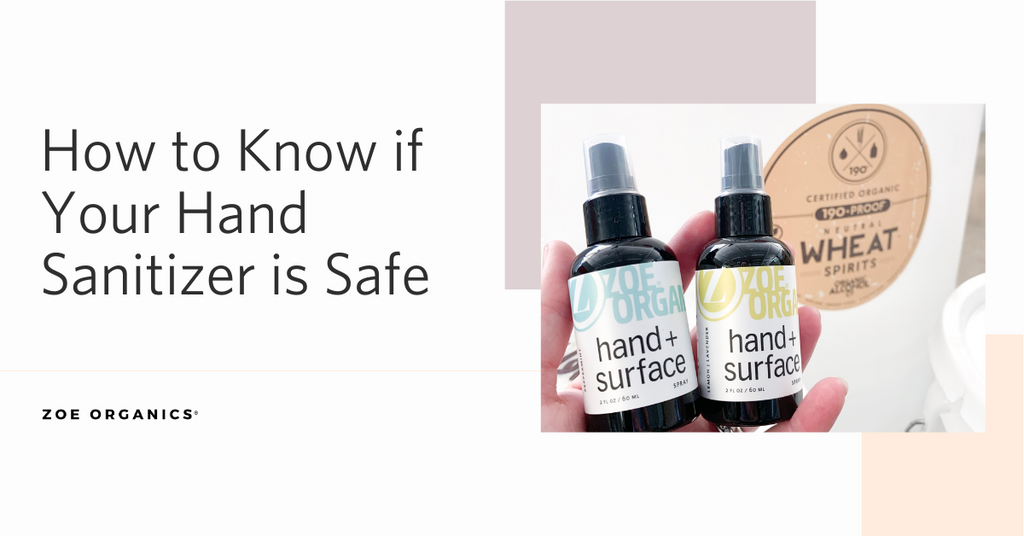How to Know if Your Hand Sanitizer is Safe

You are aware that not all personal care products are created equal. But have you ever given much thought to hand sanitizer? Maybe you didn't think much about it before the pandemic hit this year. Maybe it was a bit of an afterthought, until it became scarce. If you have been among the millions of consumers trying to get their hands on hand sanitizer, you've seen the many new and questionable options now on the market.

Similar to toilet paper, hand sanitizer flew off the shelves in March. The mass brands like purell and germx disappeared and even the popular natural sanitizers found at natural grocers like Whole Foods were out of stock in stores and online. What happened next was a surge in subpar, unregulated and potentially dangerous products.
Alcohol, the germ busting superpower in hand sanitizer (the "active ingredient"), suffered a shortage due to demand, and some companies began using less-expensive, low quality counterparts. The FDA has recently recalled hand sanitizers sold at Costco, Wal-Mart and other chains due to toxic levels of methanol or "wood alcohol" in them. Wood alcohol, if absorbed through the skin can cause serious injury, including blindness and require hospitalization. If it is ingested, it can be deadly. Yikes!!
There are 3 types of alcohol typically listed on an ingredient label: isopropanol (or isopropyl), ethanol (also called ethyl alcohol or grain alcohol), and n-propanol. It is listed as a percentage and the CDC recommends a formula of greater than 60% ethanol or 70% isopropanol to be effective. But how do you decipher how different concentrations or "proof" impact the formula? Is 70% isopropyl alcohol you find at the drug store the same as 95% ethanol or grain alcohol? No. It is important to note that the concentration of alcohol and the measured volume of alcohol in the final formula are not the same. An alcohol with a lower concentration will require a higher volume in the formula to reach the desired/required strength.
The United States Pharmacopeia (USP) uses this formula to calculate the correct volume of alcohol required for an effective formula.
(final % alcohol ) × (final volume of preparation) / (starting % alcohol ) = volume of starting ingredient required
So, if we are using a 70% isopropyl alcohol solution and we need it to be a least 60% of the final formula, we can calculate the percentage needed depending on the total volume of the formula.

According to PubMed.gov, The antimicrobial activity of alcohols is attributed to their ability to denature and coagulate proteins. This causes microbes to lose their protective coatings and become non-functional. Notably, higher than recommended concentrations are also paradoxically less potent because proteins are not denatured easily without the presence of water. Alcohol concentrations in antiseptic hand rubs are often expressed as percent by volume and rarely as percent by weight.
The type of alcohol used is important. As we saw above, alcohol containing methanol was potentially very toxic. The tricky part is that an ingredient panel can list "ethanol", but it can be a low quality denatured version, which contains contaminants such as methanol, acetone, methyl ethyl ketone and denatonium. Manufacturers consistently cut corners to reduce the cost of their raw materials, sometimes putting their customers at risk. These unpurified alcohols often smell repugnant and require additional fragrance to mask the odor.
There are plenty of other inert ingredients common in hand sanitizer, that make the texture feel great or smell pretty, but they should be used with caution. These include, propylene glycol (irritant to those with eczema and other skin allergens), aminomethyl propanol (restricted in EU and Canada in cosmetics because it may contain nitrosamines), artificial fragrance and artificial colors.

Hand Sanitizers CAN be safe, beneficial, (and we dare say) enjoyable to use. You just have to know what to look for! To help you, we've compiled a list of suggestions:
1. Know who you are purchasing from. Whether it is a small or large company, trust is gold.
2. Read ingredients lists. If you aren't familiar with an ingredient listed, do a little research to better understand it and its purpose in the formula. Even brands claiming to be "natural" and "safe" still include questionable ingredients. We see it all. the. time.
3. Ask questions! Don't just take something for face value. Contact a brand and ask for clarification or additional information. Find out what kind of alcohol is used in a particular formulation and where it is sourced from. Reputable brands will often share these details on the products pages or website.
4. Visit the FDA for a list of hand sanitizers that have been recalled and check to make sure you haven't purchased any of them.
In the spirit of true transparency, check out the ingredients lists below for our Hand + Surface Spray and email or message us with any questions!
We sourced premium, certified organic, USP grade, Non-GMO verified, gluten free, vegan, 190 proof (95%) neutral wheat ethyl alcohol and paired it with distilled water, organic glycerin and some of our favorite organic essential oils.
Stay safe and well!
xoxo



Comments on this post (1)
I have read that Purell hand sanitizer contains a carcinogenic substance called nitrosamines. Is that correct?
— betsycombs@gmail.com